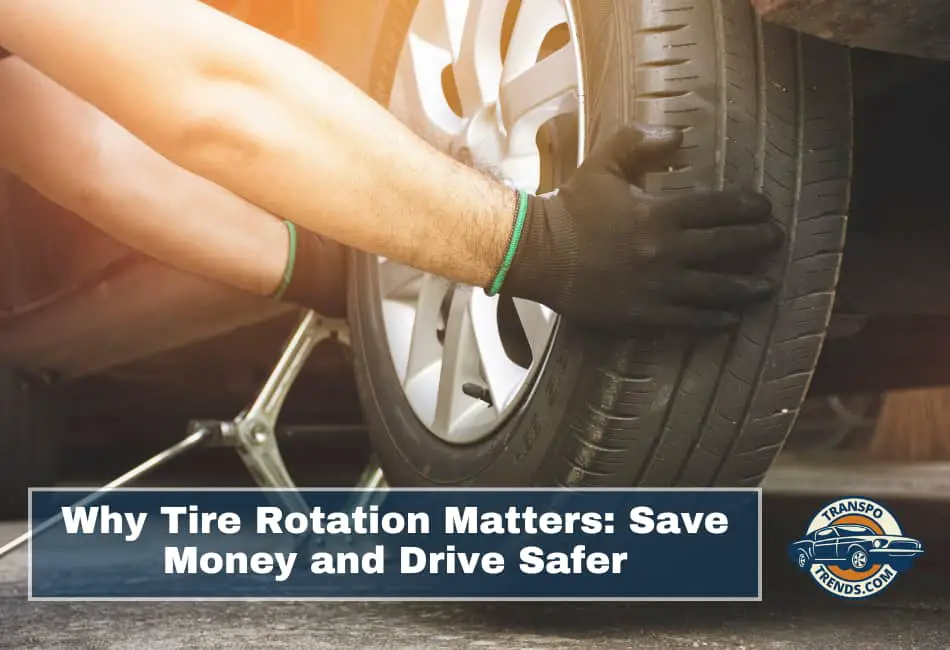Tire maintenance might not be the flashiest part of vehicle ownership, but it is one of the most impactful. Among the many things you can do to preserve your tires and stay safe on the road, regular tire rotation ranks high on the list.
For drivers who value long-term performance, smooth handling, and cost savings, tire rotation is a simple habit with big returns.
In this post, we explore the real benefits of tire rotation—backed by data, simplified for clarity, and tailored for daily drivers who want practical advice.
Whether you drive a compact commuter, a family SUV, or a work truck, this guide will show you why tire rotation is worth prioritizing.
What Is Tire Rotation?
Tire rotation is the process of changing the position of each tire on your vehicle, typically from front to rear or side to side, to ensure all four tires wear down evenly.
Different wheels endure different levels of stress depending on your vehicle’s drivetrain, weight distribution, and how you drive.
- Front tires in front-wheel-drive cars handle steering and the majority of the engine’s power, wearing down more quickly.
- Rear tires might experience different wear patterns, especially in rear-wheel-drive vehicles or when carrying heavy loads.
- All-wheel-drive vehicles distribute power more evenly but still require rotation to avoid subtle imbalances in wear.
Over time, these position-based differences create irregular tread wear, which reduces tire life, performance, and safety. Tire rotation equalizes that wear across all four corners of your car.
1. Extends Tire Lifespan
Research shows that regularly rotated tires can last 20% to 30% longer than those left in one position. That is a substantial difference when you consider that most new tires cost anywhere from $100 to $250 each.
Even tread wear helps each tire reach its full mileage potential. A tire designed to last 60,000 miles is more likely to achieve that figure if rotated consistently.
Otherwise, two tires might wear out at 40,000 miles, forcing an early replacement for the whole set—an unnecessary expense.
2. Enhances Safety and Handling
Uneven tread leads to inconsistent traction, which can compromise your vehicle’s ability to grip the road. This is especially noticeable in wet, icy, or uneven road conditions.
A vehicle with two well-worn front tires and two nearly new rear tires, for example, might handle unpredictably during emergency stops or tight cornering.
Even wear ensures that all tires perform similarly in terms of braking and grip. This balance improves overall handling, keeps your steering response sharp, and shortens stopping distances in poor weather.
3. Boosts Fuel Efficiency
Uneven tires create rolling resistance, which makes your vehicle work harder to maintain speed. As the engine compensates, it burns more fuel.
The U.S. Department of Energy has estimated that proper tire maintenance, including rotation, can improve gas mileage by up to 3.3%.
While that number might sound small, it adds up. Over the life of a vehicle, keeping your tires in optimal condition can mean fewer trips to the gas station and lower overall fuel costs.
If you are conscious of your fuel budget, tire rotation is a smart, low-cost strategy to get more miles per gallon.
4. Saves You Money on Repairs and Replacements
A new set of tires for a typical passenger vehicle can run you anywhere from $400 to $1,000. Add in the cost of a possible wheel alignment or suspension repair (often needed when uneven tires strain your vehicle), and the bill grows.
Tire rotation is a preventative step that typically costs between $20 and $50 per service. In many cases, it is offered free as part of routine oil changes or tire services.
For a minimal cost, you can delay replacements, avoid unnecessary repairs, and protect your entire suspension system.
5. Maintains Vehicle Performance and Comfort
Tires that wear unevenly can affect your vehicle’s performance. You might notice vibrations at higher speeds, a slight pull to one side, or an increase in road noise. All of these are signs that your tires are not wearing uniformly—and could benefit from a rotation.
Keeping tire wear balanced ensures smoother rides, more responsive steering, and better overall comfort behind the wheel.
For those who drive long distances or frequently encounter highway speeds, this can make a meaningful difference in daily driving experience.
How Often Should You Rotate Your Tires?
Most manufacturers recommend rotating your tires every 5,000 to 7,500 miles, though this can vary based on your driving conditions and vehicle type.
Here is a simple rule of thumb:
Rotate your tires every time you get an oil change.
This rule is particularly convenient for drivers with shorter oil change intervals (around 5,000 miles), but it also works for those using synthetic oils with 7,500-mile change intervals.
You should also consult your vehicle owner’s manual for rotation guidelines specific to your make and model. AWD vehicles, for instance, may require more frequent rotation to prevent uneven tread from damaging the drivetrain.
Signs You Are Overdue for Tire Rotation
Even if you have not hit the mileage mark, your car might already be hinting that it is time for a tire rotation. Watch for:
- Uneven tread depth between front and rear tires.
- Vibrations at highway speeds.
- Pulling to one side when driving on a straight road.
- Increased tire noise or a “humming” sound.
- Reduced fuel efficiency without other explanations.
These are all indicators that your tires are wearing unevenly and could benefit from a rotation.
Choosing the Right Rotation Pattern
Not all tire rotations are the same. The correct pattern depends on your drivetrain and tire type.
| Drivetrain | Suggested Pattern |
|---|---|
| Front-Wheel Drive | Forward Cross or X-Pattern |
| Rear-Wheel Drive | Rearward Cross or X-Pattern |
| All-Wheel Drive | X-Pattern |
| Directional Tires | Front-to-Rear (same side only) |
Always refer to your vehicle manual or consult a mechanic to confirm the best pattern for your setup.
You can also view a helpful breakdown of these patterns in this Bridgestone guide which includes diagrams and scenarios based on common tire configurations.
Rotation Tips for Maximum Benefit
To make sure you are getting the most out of your tire rotation:
- Check tire pressure after rotation, since front and rear tires may require different pressures.
- Inspect for damage, such as cuts or embedded nails, while the tires are off.
- Align with oil changes so you do not forget.
- Ask for balancing or alignment checks at the same time, especially if you feel any vibration or pulling.
Even better, keep a small maintenance log in your glovebox or phone, noting each rotation’s mileage and date.
Common Myths About Tire Rotation
Let us clear up a few misconceptions:
- “Only front-wheel-drive cars need rotation.”
False. Every drivetrain benefits from rotation, including rear-wheel and all-wheel-drive vehicles. - “You only rotate when tires start to wear unevenly.”
Actually, by the time you see uneven wear, it may already be too late. Rotation is preventative. - “Rotation is too expensive.”
Compared to replacing tires early, paying for rotation is very affordable—and some shops include it free with other services.
Final Thoughts
Tire rotation is not just a technical detail for car enthusiasts—it is a vital part of everyday vehicle care. It saves money, improves safety, boosts fuel economy, and ensures a smoother, more comfortable ride.
For the average driver, staying on top of tire rotation is one of the smartest maintenance moves you can make. It is affordable, quick, and pays off in tangible ways over the life of your tires and your vehicle.
Whether you visit your trusted mechanic or choose to do it yourself, regular tire rotation belongs in every maintenance plan.
For more information on tire care best practices, visit the National Highway Traffic Safety Administration for reliable, government-backed guidance on tire safety and maintenance.

